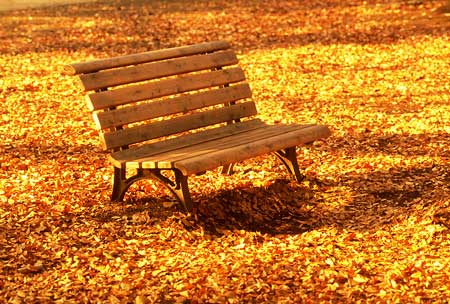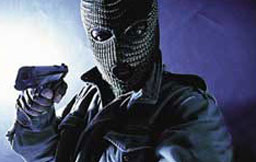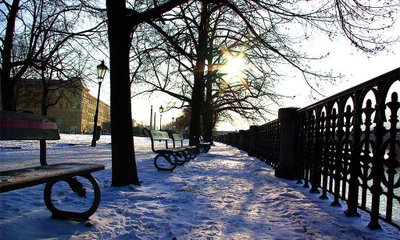Of all the great Middle European capitals, Prague alone escaped the unusually harsh treatment to which twentieth-century Europe has subjected its cities, the vandalism of fire bombs and artillery shells, the cruel steel-and-glass grafts of post-war reconstructive surgery.
Prague has the especial sadness of being the last of her kind, tragic as Martha the passenger pigeon, the sole remaining speaker of Cornish or Ute, a lyrical couplet by a Roman poet which alone of all his works has survived the thousand plunderings of the libraries of the world. Even the native name of the city – Praha – sounds like a sigh of bereavement; in English the name has undertones of ‘prayer’ and ‘fog,’ and a gauzy gray shimmer of ‘mirage.’
Now that Czechoslovakia has awakened from its forty-year iron dream, Prague, as do all sole survivors and last exemplars of their race, has drawn a crowd. My traveling companion, A., and I were unable to book ourselves a room in the notoriously hotel-free city as late in the season as October, and we were met at the airport by a representative of one of Prague’s many private-apartment booking agencies, and driven in a rattling Sk-da hatchback to our own little flat.
There are some very nice hotels in Prague – the Ungelt, the Three Ostriches, Pension U Raka – but we stayed in an apartment belonging to a family named Cerny, on the third floor of a sagging old Beaux-Arts block on Lederova Street. It had two big rooms with high ceilings and tall windows, and a large kitchen dominated by a lovely old piece of Moderne cabinetry, all curved glass and portholes and Bakelite handles, which someone – I supposed it might have been Mrs. Cerny – had had the inspiration to paint a dazzling shade of Florida orange.
The same questionable taste was reflected in the art on the walls, which consisted entirely of cheap framed prints of urchins with hypertrophied eyeballs posing coyly in front of the celebrated landmarks of Paris. The bathroom was furnished with a rather fearsome, Soviet, wall-mounted gas water heater operated by a complicated system of levers and valves, and with a toilet from which there seeped, in the middle of the night, an intermittently unbearable stench, as of years of rotten government, or the millennium of black secrets and ethno-religious atrocities on which the magical city of Prague has been built.
The Cerny’s drab, spare apartment – the owner now lived, we were told, somewhere out in the suburbs – provided us with our first taste of the thick streak of mediocrity that runs like a ribbon of fat through the meat of a visit to Prague, but it was comfortable, and reasonably clean, and I had a lot of fun one afternoon going through all of the drawers of the apartment and trying to piece together an impression of our absent landlords from the odd residue – an Abba cassette, a Chinese cocktail umbrella, an expired socialist-republic driver’s license with a photograph of a gap-toothed blonde, a desiccated insect corpse that proved on further inspection to be a false eyelash, a marbled notebook full of elegant calculations – they had chosen to leave behind.
Walled and needle-tipped Hradcany perched on its high overlook; the Vltava at once treacherous and tamed, spanned by the somber stone arches of Karlov Most; the pastel expanse of Staromestske Namesti with its bell towers and obsessive clock; the alleys of Josefov, haunted by Jewish ghosts; the car-horns and capitalistic hubbub along the half-mile of V·clavske Namesti; Castle, River, Bridge, Town Square, Ghetto, infinite Boulevard: the plan of Prague is the archetypical cartography of a city in a nightmare or a dream.
As the last of its kind, Prague must stand for every other lost European dreamville, and its configuration has the model quality of a didactic map, or of the board for a game whose pieces are the Martyr, the Bear-baiter, the Mad King, the Merchant, the Rabbi, the Astronomer, the Implacable Jesuit, the Mob, and the Anarchist with his spherical Bomb, and in which a roll of the dice may produce a holy war, an astonishing fact about the heavens, an act of misguided bravery, an authentic and lasting miracle, a philosophy, a pogrom.
The dozens of high towers and the seven hills of Prague encourage the visitor to perceive the idealized scheme of Prague, to look down upon it, as a child gazes down on Candyland; no city is more generous in offering up so many spectacular views of itself. And the roofs of Prague! The rainy blue haze of Paris, the wan brown woolen calm of London, the spiky and mechanical flatness of Manhattan – the appearance of every city is, to a great extent, determined by the nature of its rooftops. All the roofs of Prague are covered in crazy herringbone rows of red tile, and when you look out over the city – from the Powder Tower, the Town Hall Tower, the Bridge Tower – the city seems a city of rust and blood and wine, topped by five hundred spires.
At street-level the town looks far more various and wild. The streets follow the meanders of ancient herds of goat and cattle, double back on themselves, turn abruptly to stairways and tunnels and belvederes; the squares are not square; the cobbles are set into the roadbeds in endless ragged arcs and fans of stone, while a million tiny black and white tiles pave the sidewalks, no two of them quite the same size or shape. At times it seems that all the lines of Prague have been drawn by a gnarled and trembling hand.
The buildings, public and private, stand painted the colors of Easter eggs and fondants and all the rich yellows of the creamery; and the long swell of the Baroque, in washing across the houses of Prague, left behind it an astonishing sea wrack of putti, saints and twisted seashells, a rich foam of seraphim and horses.
Many houses are completely covered, from pavement to eaves, in scratchy sgraffito cartoons, drawn right into the stucco, of eagles and angels, centaurs and big-bosomed queens; others have not been painted so much as illuminated, with the the florid Art-Nouveau marginalia of Mikol·s Ales and his followers. Indeed there is so much quirky artifice here, such unrelenting charm, that after a while I grew suspicious and began to wonder if I had not fallen victim to a fraud.
Prague can have a way of looking disturbingly fake, as though the entire place were really nothing but a theme-park scale model, in canvas and plaster and paint, of the ultimate Central European chocolate-box city, the shadowy capital of Zembla, encrusted with all the trumpets-and-cherubs confectionery of the Baroque style, run by clockwork and steam.
And yet five hundred years of prisoners died in the stinking oubliette of that fanciful tower; in that green-roofed palace Johannes Kepler sketched out the Laws of Planetary Motion; in the middle of that square handsome Jan Palach doused himself in gasoline and struck his last heroic match. Prague is a real city, built up over the course of a millennium by real men and women.
It has, as no disneyland ever can, the unmistakable patina or stain of human habitation. And so I had to ask myself, as I did while rummaging through the drawers of the Cerny’s desk: What kind of people could have left all this behind them? Watching the current residents of Prague go about their unimaginable business it was, I am ashamed to admit, difficult to believe that they or anyone like them could have produced such a whimsical, such a spooky and vainglorious town.
It’s unfair to judge a people when you have not chatted with them, visited them in their homes, understood the patter of their deejays or the clamor of their headlines or the banter of their kids. I know this.
The separation of citizens and foreigners in Prague is so complete that it seemed almost a kind of metaphysical apartheid, like that which segregates the living and the dead. It was as though the Praguers were inhabiting a different city, on another dimensional plane, and in that other Prague I appeared only intermittently, a bodiless, nearly invisible hologram, asking for directions. I attribute this failure to communicate to a flaw in my character, and not theirs.
But you look down from the riot of angels, from the foamy pediments and leafy pilasters and the weathervane hats of the palaces, to the subdued, pimply couple sitting beside you on a bench in Bethlehem Square, in their plastic leather pants, making love to one another with dour lips and listless hands, and cannot help feeling terribly let down. You feel the people of this city ought themselves, like their buildings, to wear pointed hats and swirled turbans and candy-colored, checkerboard gowns; instead you find a city of bad haircuts and rank smoke, the smell of beer and armpit, a persistent hacking cough.
I suppose it is unfair to expect that any contemporary people could live up to or appear worthy of a city such as Prague, but it was hard not to be aware of an air of diminution in the citizenry of Prague, as in some grandiose jungle ruin in the Yucatan, a city of giant pyramids and canals, in the weedy, shattered plaza of which a sullen child crouches, poking with a stick at a peat moss fire; and the archaeologist, gazing up at the colossal remains, strokes his chin and thinks, What happened here? Could forty years spent trapped within the Bloc, I wondered, have drained so much from the people of a city?
And then, on the third day of our stay in Prague, we visited the remnants of the Jewish ghetto, a crooked aleph of three narrow streets at the center of the Josefov quarter, where the Vltava makes a bend to the east before snaking west again and resuming its short northward run toward the Elbe.
If Prague can at times remind the visitor of the crooked little scale-model Central European town in every Republic horror film of the thirties, huddled at the foot of its castle hill, then Jew-hating is the monster in the keep. The city had a long tradition of persecution and pogrom; until the nineteen-fifties one of the carved figurines joining in the dance of the hours on the face of city’s delightful Astronomical clock was a horned Jew, shaking his money bags. A turn-of-the-century program of ‘sanitization’ obliterated most of the ghetto, a process that was halted by Hitler himself, because he intended here to establish his ‘Museum of an Extinct Race.’
And so the ghetto’s six remaining synagogues, including the 13th-century Alt-Neu, under whose stair-stepped gables the Golem reputedly sleeps his nameless sleep, were not demolished; the madly snaggled teeth of the headstones in the cemetery were not plowed under. Everything that remained of the Prague ghetto by 1938 is still here, and in remarkably good condition. Only the Jews are gone. This was my first visit to a city that had lost its Jews, and I wondered if this were not the catastrophe that had left the city’s populace looking so diminished.
The old cemetery was on this gray October afternoon filled with German tourists, shuffling politely among the graves, their expressions mild and illegible. They called out one another’s names, and stooped to run their hands over the Hebrew inscriptions, and left behind their unimaginable wishes, scrawled onto scraps of paper. This custom is an odd permutation of the traditional leaving of a stone at a Jewish graveside, unique, in my experience, to the old Prague cemetery, where people use bits of rock, pebbles, and even their pocket change to weigh down their written supplications, or they cram their messages into the cracks in the weathered old tombs.
The grave of Rabbi Loew ben Bezalel, the Golem’s creator, draws the biggest crowds and it’s littered with prayers, an ornate stone parade float strewn with the confetti of hearts’ desires. It seems to stand at some strange metaphysical conjunction of the Western Wall of the Temple with the grave of Jim Morrison.
As a child I was fascinated by the Golem, the legendary automaton formed by Rabbi Loew from clay and the Name of God, and I wanted to visit with the great Rabbi, but with so many people standing around it was difficult to get close, and when I did I found myself faced with a block of unreadable stone and the commentary of a German tour guide, holding aloft her little black flag. “Let’s get out of here,” I said to A. Although the cemetery, with its elder trees, is weird and lovely, I felt uncomfortable there, surrounded by all those unfulfilled wishes and by the startling irony of ordinary German voices in that place, with layer upon layer of dead Prague Jews beneath my Nikes.
We didn’t leave a stone.
I passed a troubled afternoon wandering the streets of the city’s Old Town. It seemed particularly painful to me now when I remarked that the two most popular symbols of the city – the images that appear, over and over again, on the T-shirts and posters sold by Prague’s fledgling souvenir industry – should be those of the Golem and of Franz Kafka, the penultimate Prague Jew; should be the emblems of a Prague utterly and forevermore extinct. But then I thought that maybe there was something fitting in this choice, unconscious as it may have been, to symbolize Prague with a couple of Jewish ghosts, because the city itself is a kind of ghost, a revenant from a lost world, a reminder that we may have to account the great European idea of the city itself among all the things to have perished in the course of the last century.
Even the greatest glory of Prague, the legacy of her Catholicism, seemed in spite of all her thrilling Baroque churches simply that, a legacy, the residue of a lost era of splendid and barbarous enchantment. The Jesuits, in their successful battle to recapture Prague from the forces of Reformation, availed themselves of the entire mad arsenal of the miraculous, and the city is particularly rich in bizarre icons – all miracles are by definition bizarre – and in the wonder-working body parts of saints.
In the church of Loretto there is a shrine to St. Wilgefortis, a young maiden who prayed to the Virgin to be spared marriage to an impious lout and awakened the next morning with the thick black beard of Rutherford B. Hayes; and a painting of St. Agatha, gaily proffering to an angel a dainty platter on which sit, like a couple of trembling blancmanges, her severed breasts. In the church of Our Lady of Victories is the famous Bambino, or Infant of Prague, a small waxen miraculous image of the Baby Jesus, a kind of holy dress-up doll replete with a full wardrobe of high-fashion outfits which are dutifully and regularly changed.
There are all manner of severed tongues and noses and sacred knucklebones; and yet in all these relics, in every grandiose and empty church, I found something dilapidated and sad; the bones of SS. Just and Boniface in St. Thomas church, abandoned to their dusty glass cabinets, dressed in their moth-eaten finery, reminded me a little of the forgotten exhibits one used to come across in the shadowy basement rooms of the Carnegie Institute in Pittsburgh, the skeletons of Delaware Indians and passenger pigeons, the tattered remnants of a coonskin cap.
All these seemed relics not simply of the holy men and women of the Church but of an entire Empire of Wonders of which Prague was once a provincial capital, remnants of a time when not only the city but its citizens were capable of wild acts of architecture and belief.
I was still feeling somehow bereft by Prague that evening, our last in the city, when A. and I left the Cerni’s malodorous apartment to keep a dinner reservation at U zlatehrusky, in the Hradcany district. The Golden Pear lies at the end of a street in Novy Svet, or ‘new world,’ a wondrous little town within a town within a town, a tiny medieval village tucked into the shadowy folds of the scarp of Prague Castle.
Daylight savings had ended a few days earlier and evening seemed to have come on awfully quickly. We held hands and picked our way along the cobblestones. There was no one else around and the street around us filled up quickly with shadows. On one side of us ran a row of low, red-roofed cottages, on the other a high, rambling stucco wall that enclosed some all-but-inaudible garden of leafy trees and fountains.
The lights came on, one after another, down the curve of the narrow street, and we could see that in all these five-hundred-year-old houses it was almost suppertime, again. Our restaurant took up both floors of the last cottage on New World Street, and as we ducked down into the candlelight and the smell of frying onions, I put my arm around A.’s waist, and all at once I felt no sense of loss, only hunger, and the warmth of my blood in my cheeks, and gratitude that after all so much should have been left behind.
Originally published in The New York Times ©1992 Michael Chabon (Random Dendrites)





